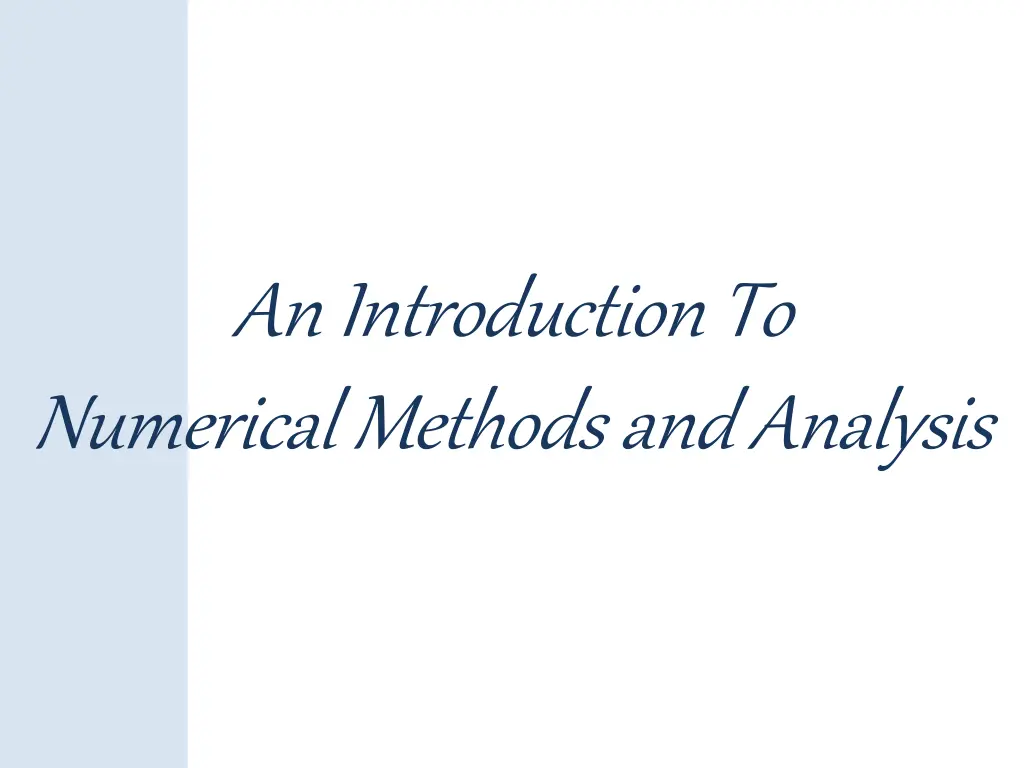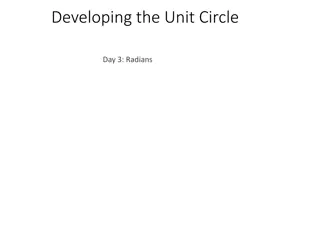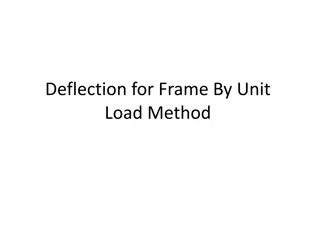
Introduction to Numerical Methods and Nonlinear Equations
Explore the fundamental problems of numerical analysis with a focus on solving nonlinear equations using iterative numerical methods. Learn about different types of nonlinear equations and how to formulate them for numerical solutions.
Download Presentation

Please find below an Image/Link to download the presentation.
The content on the website is provided AS IS for your information and personal use only. It may not be sold, licensed, or shared on other websites without obtaining consent from the author. If you encounter any issues during the download, it is possible that the publisher has removed the file from their server.
You are allowed to download the files provided on this website for personal or commercial use, subject to the condition that they are used lawfully. All files are the property of their respective owners.
The content on the website is provided AS IS for your information and personal use only. It may not be sold, licensed, or shared on other websites without obtaining consent from the author.
E N D
Presentation Transcript
An Introduction To Numerical Methods and Analysis
In this chapter we study one of the fundamental problems of numerical analysis, namely the numerical solution of nonlinear equations. Most equations arising in practice are nonlinear and are rarely of a form which allows the roots to be determined exactly.
Consequently, numerical methods are used to solve nonlinear algebraic equations when the equations prove intractable to ordinary mathematical techniques. These numerical methods are all iterative, and they may be used for equations that contain one or several variables.
A nonlinear equation in this chapter may be considered any one of the following types: 1. An equation may be an algebraic equation (a polynomial equation of degree n) expressible in the form: where For example, the following equations are nonlinear. are constants.
2. The power of the unknown variable (not a positive integer number) involved in the equation must be difficult to manipulate. For example, the following non-polynomial equations are nonlinear
3. An equation may be a transcendental equation, the equation which involves the trigonometric functions, exponential functions and logarithmic functions. For example, all the following transcendental equations are nonlinear
Given nonlinear equation must be put in the following form f(x) = 0, where f(x) must be nonlinear function.
There may be many roots of the given nonlinear equation but we will seek the approximation of only one of its real root lies in thegiveninterval[a,b],thatis f( ) = 0, where [a, b].
If f(x) is continuous function in a interval [a, b] and f(x) has opposite signs at the end points of the interval, then there must be a root of nonlinear equation f(x) = 0 in [a, b].
Root of a nonlinear equation may be simple (not repeating) or multiple (repeating). Simple root means For example, are the simple roots of the nonlinear equation
For the multiple root, we mean For example, are the multiple roots of the nonlinear equation
The methods we will consider in this chapter are iterative methods and they are, Bisection method, fixed-point method, Newton method (also called, Newton-Raphsonmethod) and secant method which give us the approximation of single (or simple) root of the nonlinear equation.
For the multiple roots of the nonlinear equation we will use other iterative methods, called, the first modified Newton s method (also called the Schroeder s method) and the second modified Newton s method. The iterative methods for the approximation of simple root can be use also for the approximation of the multiple roots but they are very slow.
All the numerical methods described in this chapter are applicable to general nonlinear functions. The iterative methods we will discuss in this chapter are basically of two types: one in which the convergence is guaranteed and the other in which the convergence depends on the initial approximation.
Remember that the best method for the approximation of the simple root of nonlinear equation is Newton s method (called quadratic convergent method) and for multiple root of nonlinear equation is modified Newton s method (called quadratic convergent method). Newton s method for multiple root of nonlinear root is called a linear convergent method.
Definition (Root of an Nonlinear Equation) Assume that f(x) is a continuous function. A number for which f( ) = 0 is called a root of the equation f(x) = 0 or a zero of the function f(x).
First, we shall discuss the numerical iterative methodsforsimplerootofnonlinearequationsina singlevariable. Theproblemherecanbesimplywrittendownas: f(x) = 0.
This is one of the simplest iterative technique for determining roots of f(x) = 0 and it needs two initial approximations to start. It is based on the Intermediate Value Theorem.
This method is also called the interval-halving method because the strategy is to bisect or halve the interval from one endpoint of the interval to the other endpoint and then retain the half interval whose end still bracket the root.
It is also referred to a bracketing method or sometimes called the Bolzano s method. The fact that the function is required to change sign only once gives us a way to determine which half interval to retain; we keep the half on which f(x) changes sign or became zero.
The basis for this method can be easily illustrated by considering a function y = f(x). Our object is to find an x value for which y is zero.
Using this method, we begin by supposing f(x) is a continuous function defined on the interval [a, b] and then by evaluation the function at two x values, say, a and b, such that f(a)f(b) < 0.
The implication is that one of the values is negative andtheotherispositive. These conditions can be easily satisfied by sketchingthefunction,
the function is negative at one endpoint a of the interval and positive at other endpoint b and is continuouson a x b. Therefore the root must lies between a and b (byIntermediateValueTheorem)andanew approximationtotheroot becalculatedas
+ a b = c 2 + a b = . 1 ( ) , n n c n n 2 The iterative formula ( ) is known as the bisection method method. bisection
If f(c) 0, then c is the desired root, and, if not, then there are two possibilities. Firstly, if f(a) . f(c) < 0, then f(x) has a zero between point a and point c. The process can then be repeated on the new interval [a, c].
Secondly, if f(a) . f(c) > 0 it follows that f(b) . f(c) < 0 since it is known that f(b) and f(c) have opposite signs. Hence, f(x) has zero between point c and point b and the process can be repeated with [c, b].
We see that after one step of the process, we have found either a zero or a new bracketing interval which is precisely half the length of the original one. The process continue until the desired accuracy is achieved. We use the bisection process in the following example.
Turbo C++ http://www.4shared.com/rar/uBzQ2hqoce/Borl and_Turbo_C_45.html? Program Code http://faculty.ksu.edu.sa/dr.abhari/DocLib1/%D8%B1%D9%8A%D8%B6%20254%20%D8%A7%D9%84%D8%B7%D8%B1%D8%A7%D8%A6%D9%8 2%20%D8%A7%D9%84%D8%B9%D8%AF%D8%AF%D9%8A%D8%A9/%D8%A7%D9%84%D9%88%D8%AD%D8%AF%D8%A9%20%D8%A7%D9%8 4%D8%A3%D9%88%D9%84%D9%89/bisectio.cpp http://www.4shared.com/rar/r6farDfLce/SetupGraph-442.html
Example 1 2 , 5 . 1 = ; 1 3 ( ) 2 f x x x
Example Example Use the bisection method to find the approximation to the root of the equation that is located in the interval accurate to Within
#include<stdio.h> #include<math.h> float a,b,c; int i; float f(float x) { float y; y=pow(x,3)-2*x-1; return y; } main() { i=1; a=1.5; b=2; for(i=1;i<=6;i++) { c=(a+b)/2; printf("%.6f\t",c); printf("%.7f\n",f(c)); if(f(a)*f(c)<0) b=c; else a=c; } return 0; }
Example 2 4 , 1 = x 3 ( ) 20 ; f x
Example 3 3 , 2 = 3 ( ) 4 ; 9 f x x x






















